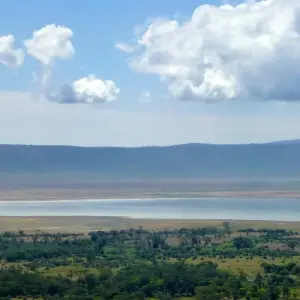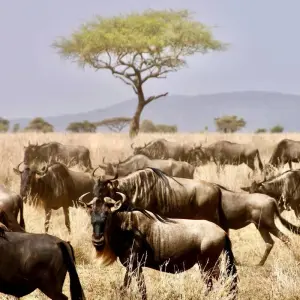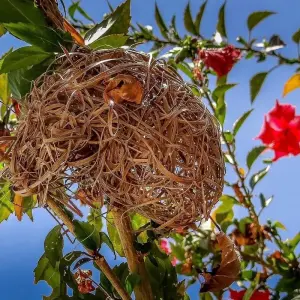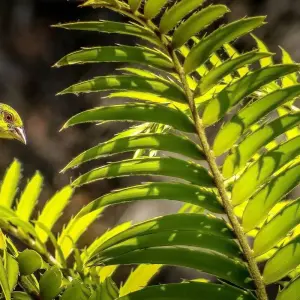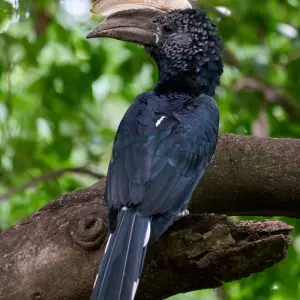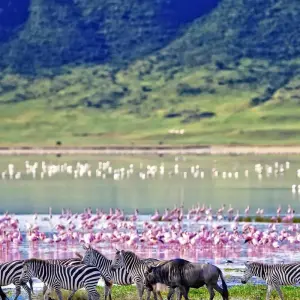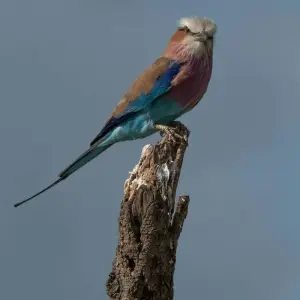Your driver-guide and our representative will greet you when you arrive at Kilimanjaro International Airport. To the Rivertrees Country Inn we will transport you. This beautiful resort provides breathtaking views of Mount Meru and Mount Kilimanjaro and is located on a historic German coffee farm along the scenic Usa River. Over 100 different bird species have been recorded near the lodge; owls, in particular, prefer to perch atop the tall trees that surround it. For bird watchers, even wandering around the lodge grounds itself is a treat. You will be met at the resort by our safari manager, who will give you a briefing on the safari before supper. Breakfast, lunch, and dinner on the menu.
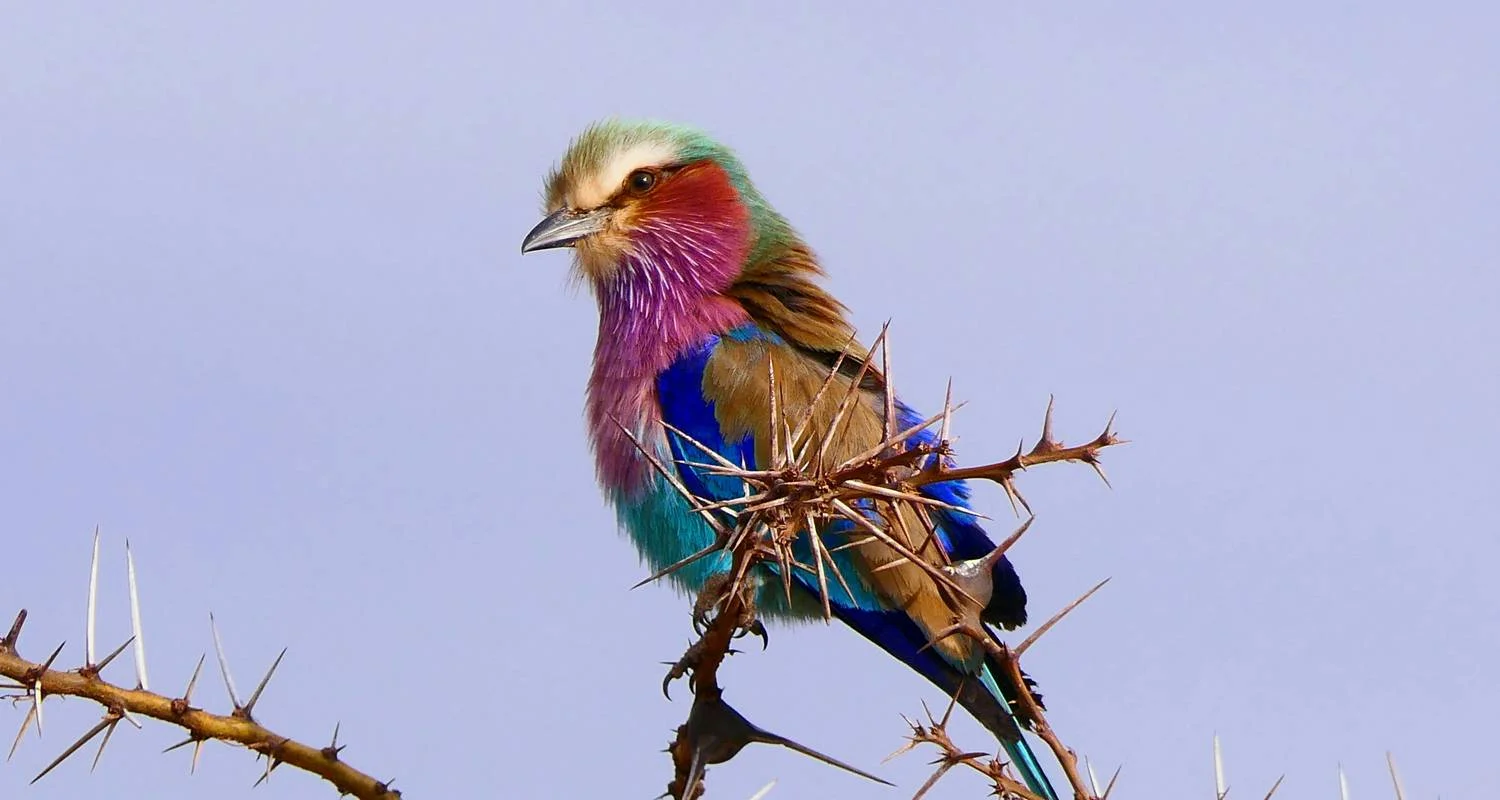
14 Days Bird Watching
Программа тура
Arrival
Arusha National Park
Spend the whole day watching animals and birds at Arusha National Park. Take in the breathtaking views of the magnificent Mount Kilimanjaro and large flocks of vibrant flamingos at Momella Lake while enjoying a picnic lunch. Drive a game vehicle across the many ecosystems of this breathtaking park. The park in northern Tanzania is home to black and white colobus monkeys, Sykes and vervet monkeys, timid forest duikers, leopards, and large herds of antelope. You will walk the steep slopes of Mount Meru through thick woodland or around the rim of Ngurduto Crater under the guidance of an armed ranger. In this stunning national park, birds are abundant. Species to watch for include the silvery-cheeked hornbill, Hartlaub's turaco, and different waterbirds including the yellow-billed stork and many more. Afternoon at the hotel. Included are all meals.
Tarangire National Park
You go towards Tarangire National Park, Tanzania's third-largest national park and a refuge for an exceptionally high elephant population, from Arusha National Park. The park's majestic baobab trees, which dwarf the animals that graze underneath them, are an intriguing feature. Since the Tarangire River is the sole source of steady water in the region, animals congregate there. There is a wide variety of animals there, including up to 6,000 elephants plus lion, leopard, and cheetah. At the park's limits, a walking tour with a Masai guide or ranger is also included. There are several birds to hear and view right at Tarangire National Park's entrance. Of course, superb starlings are everywhere, but other species that may be seen in the national park include the lilac-breasted roller, buffalo weaver, ostrich, white-backed vulture, red-billed hornbill, magpie shrike, Fischer's lovebird, and several birds of prey. Lodge overnight stay. Included are all meals.
Lake Manyara National Park
We go for Lake Manyara after breakfast. The park, which is tucked away at the foot of the Great Rift Valley escarpment, is renowned for its breathtaking splendor. Numerous game creatures, including buffalo, elephants, giraffes, impalas, hippos, and others, may be seen. The lake itself occupies the great bulk of the park's land, therefore it stands to reason that this region of Tanzania is well-known for its water birds. Along with dozing hippos and trotting warthogs, the lakefront is home to large flocks of greater and lesser flamingo, great white pelicans, great white egrets, cormorants, and plovers. Stay the night at the adjacent Ngorongoro Farmhouse in Karatu. Included are all meals.
Lake Manyara - Serengeti
You leave for Serengeti National Park after breakfast. There will be a picnic lunch available. You will make a stop at the Olduvai Gorge along route where anthropologists Louis and Mary Leakey unearthed several important finds that helped support the idea that human existence started in Africa. On a kopje (rock protrusion) in the Serengeti, you will pause for your picnic lunch before continuing on for a wildlife drive. The Serengeti is the most well-known wildlife refuge in the world and is home to several kinds of common animals, ranging from the hare to the elephant. The Masai term "Siringet," which denotes an infinite plain, gave rise to the name Serengeti. Sacred ibis, goliath herons, yellow-billed storks, Egyptian geese, plovers, and other water birds congregate at the Serengeti's many watering holes. In addition, the area is home to over 450 different species of birds, including the kori bustard, lappet-faced vulture, marabou stork, grey heron, hamerkop, secretry bird, numerous sparrow hawks, numerous eagles, helmeted and crested guinea fowl, cuckoos, kingfishers (including pied and malachite), bee-eaters, rollers, horn Serengeti camp overnight. Included are all meals.
Serengeti
A full day of Serengeti wildlife drives. You may expect to witness wildebeest, lions, elephants, giraffes, zebras, monkeys, baboons, hippos, rhinos, antelopes, and many birds and other species, depending on the time of year and the herds' journey. Serengeti camp overnight. Included are all meals.
Ngorongoro
Drive to Ngorongoro Crater in the morning. You will descend into the Ngorongoro Crater, which is sometimes referred to as one of the world's marvels, after arriving for a magnificent wildlife drive (with a picnic lunch). It is the biggest intact volcanic caldera in the world and a natural haven for some of the densest animal populations in Africa. One of the few locations where the endangered black rhino may be seen in its native habitat. A picnic will be had at the water bird-friendly Lake Magadi. The amazing variety of plants that can be found in this very small region is being taken advantage of by a large number of birds near the crater bottom. Turacos swiftly dart from tree to tree while ostrich and kori bustard graze the flat grasslands. Black kites soar above. The "Big Five" may, with some luck, be seen on only one game drive. Lodge overnight stay. Included are all meals.
Ngorongoro to Arusha
Drive to Ngorongoro Crater in the morning. You will descend into the Ngorongoro Crater, which is sometimes referred to as one of the world's marvels, after arriving for a magnificent wildlife drive (with a picnic lunch). It is the biggest intact volcanic caldera in the world and a natural haven for some of the densest animal populations in Africa. One of the few locations where the endangered black rhino may be seen in its native habitat. A picnic will be had at the water bird-friendly Lake Magadi. The amazing variety of plants that can be found in this very small region is being taken advantage of by a large number of birds near the crater bottom. Turacos swiftly dart from tree to tree while ostrich and kori bustard graze the flat grasslands. Black kites soar above. The "Big Five" may, with some luck, be seen on only one game drive. Lodge overnight stay. Included are all meals.
Amani Nature Reserve
Start your trip to the Amani Nature Reserve in the Eastern Usambara Mountains after an early breakfast. The camp manager will greet you there and go through your schedule with you. There is time for bird viewing in the late afternoon, either at your tent or in a neighboring forest. The Usambara eagle owl and the Usambara weaver are two examples of the many bird species that are unique to the Usambara region. For those who are true bird lovers, this is a great treat! The Amani sunbird, Fischer's turaco, green-headed oriole, among other important species, may all be seen nearby. Take two days to explore the Amani Nature Reserve. Spend the night in the simple modest camp. Included are all meals.
Mkomazi National Park
Staying in Mkomazi, the newest of Tanzania's national parks, is the next stop on your adventure. It acts as a barrier for Kenya's nearby Tsavo National Park. The border in the south is formed by the Pare and Usambara Mountains. The two mountain ranges in the backdrop scenery, which alternate between sparse tree savannas and grassland, are what give the area its imposing and spectacular appearance. Thanks to the implementation of protection measures, the number of animals has also significantly grown. The gorgeous scenery more than makes up for the fact that there are fewer animals than in other of the more well-known national parks. There are over 450 different bird species that bird enthusiasts may see. Martial eagles and other hoopoes are lesser-known species, whereas secretary birds, bee-eaters, hornbills, starlings, and guinea fowl are more prevalent species. The George Adamson/Tony Fitzjohn African Wildlife Preservation Trust has breeding programs for both the endangered black rhino and African wild dogs at Mkomazi. Visit the project if you can to witness the wild dogs and rhinos. On that particular evening, you may simply embark on a guided tour of the camp or a night game drive. Camp for the night. Included are all meals.
Depart from Kilimanjaro
Depending on when you leave, you may still have time in the morning to go bird and game viewing or just rest at your camp before your guide drives you back to Kilimanjaro Airport (driving time: around three hours) to catch your flight.
Детали тура
Размещение / проживание
All nights accommodation
Транспорт
Private land cruiser with a pop -up capony for 360 degrees game viewing
Страховка
Опционально
Other activities and services are not included.
Перелет
Flights are not included.
Дополнительно
All park fees
All government taxes
Medical kit & some soft drinks in the jeep
Дополнительно
International flights
Items of personal needs
Tips
Питание
Meals as per itinerary.
Гид
Private safari guide
Хорошо знать
Валюта
Tanzanian Shilling
Танзания
Штекеры и адаптеры




